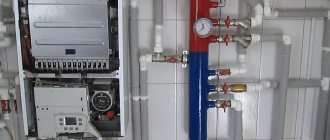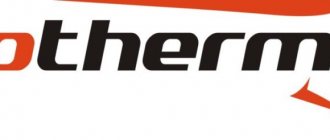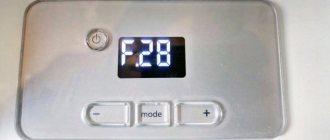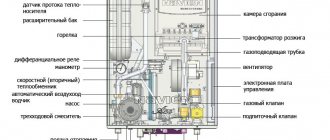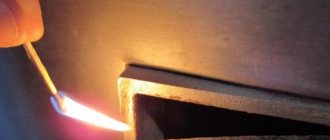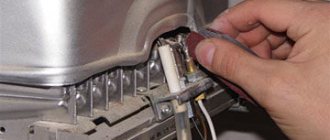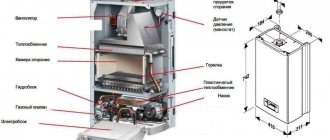Setting procedure: ...
Page 15
- Image
- Text
15
Setting procedure:
— Turn on the main switch —
Set the required heating temperature on the control panel
Operating a boiler with room temperature
regulator
If you use a room regulator on the boiler control panel, you must set a maximum heating temperature that can cover the heat loss of the facility even at low outside temperatures. In this case, the room regulator will control the heating of the heating system only in the range you select. Note:
In a room where
there is a room regulator; there should be no thermostatic valves on the heating radiators. Warning:
The manufacturer does not
assumes no liability for damage caused by incorrect settings of the boiler or room regulator.
Operating the boiler with
two-position room
regulator (ON/OFF)
In this mode, the boiler maintains the set heating temperature. The boiler operation is interrupted (on/off) depending on the internal temperature in the room in which the room regulator is located. To control the operation of the boiler, use only a regulator whose outputs are voltage-free, i.e. not transmitting extraneous voltage to the boiler. The maximum permissible load on the relay switching controller is 24 V / 0.1 A.
Operating the boiler in mode
equithermal regulation
The boiler regulates the heating temperature depending on changes in outside temperature. To use this method of regulating the operation of the boiler, an external
temperature sensor. The procedure for setting equithermal curves for this control method is described in the “Selecting a setting mode” section. Warning:
Settings
maximum heating temperature on the boiler control panel may limit the efficiency of a boiler with an equithermal regulator. When giving a command to the boiler to heat up the heating, the regulator cannot exceed the coolant temperature value set by the user on the boiler control panel. Proper setting of the heating temperature on the control panel is the only way to protect against exceeding the maximum permissible temperature of the coolant entering the heating system. Warning:
Connection
Inspection of the room regulator and outside temperature sensor can only be carried out by a specialist from a specialized organization certified by Protherm.
Underfloor heating
SKAT series boilers can be used to work with underfloor heating systems. To regulate the boiler water temperature in underfloor heating systems, an emergency thermostat must be connected to the boiler (not included in the boiler delivery package). The emergency thermostat for underfloor heating systems is connected to the terminal block intended for supply voltage (see Electrical diagram of the boiler, pos. 13). Note:
The boiler comes with
a factory-installed jumper on the emergency thermostat connection terminals for underfloor heating systems. When connecting the emergency thermostat, the jumper must be removed.
Cascade control
If the boiler power is insufficient to cover the heat losses of the facility, then 24 and 28 kW boilers can be connected to
If the boiler does not turn on
The cause of this problem may be the burnout of any electronic part: control panel, power control board, or failure of the heating element. Failure can be determined by assessing the operation of the indicator lights. For this:
- Turn on the boiler and set the desired coolant temperature. The water in the tank should be cold. Current should flow to the heating element, and the electric boiler operation indicator should light up. It is often connected to the same cable that leads to the heating element. This cable comes from the power control unit.
- Check to see if the indicator lights up. If it burns, then there is a problem with the heating element. If not, then there is a breakdown in the electronic part.
To determine the damaged node, you can use a multimeter . One end of it is applied to one output of the boiler plug, and the other - in turn to all elements connected to the cable with the plug. The second end of the multimeter is applied to each of the two contacts. If the device does not produce a signal, then there is a problem in the area between its two terminals.
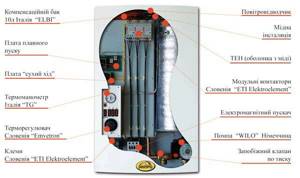
- Plug with electrical input cable.
- Control Panel.
- Power control unit.
- Thermal switch.
- Thermal sensor for overheating.
If any of these elements breaks, it must be replaced.
Boiler protective functions
Page 16
- Image
- Text
16
additional boiler. If boilers are connected in a cascade, the latter is controlled using one room regulator connected to the first, the so-called “leading boiler”. For cascade control of boilers, terminals 9 and 10 of the leading boiler must be connected to terminals 1 and 2 of the second, slave boiler, located on connector K8 of the boiler control panel. The room regulator contacts are connected to terminals 1 and 2 of the lead boiler. If two or more boilers are connected in a cascade, the subsequent boiler is always switched on a short time after the last power stage of the previous electric boiler is switched on.
Unloading relay
Using an unloading relay, you can regulate the boiler power depending on the magnitude of the electrical load in the object it heats. For this control method, for example, a “three-phase relay for electrical load control” can be used. In practice, a boiler equipped with such a device behaves in such a way that if the load on the
electrical network (washing machine, stove, electric kettle, etc.) the boiler power is automatically reduced. When the electrical load decreases, the boiler power, on the contrary, increases to the required value. This control method is used where it is not possible to increase the disconnecting capacity of the main switch of the heated facility. The external unloading relay is connected to terminals 5 and 6 of connector K8 located on the boiler control panel (see figure “Unloading relay connection diagram” located at the end of this manual). Warning:
Careful assessment
the feasibility of combined use of the boiler with an external device for automatic power reduction is carried out by the designer and service specialist. Wherein
You always need to weigh the need to operate a boiler with the above-mentioned external device, taking into account the nature of housekeeping or production. The manufacturer does not accept any liability for defects resulting from unsuitable connection and installation methods.
Boiler protective functions
Frost protection
The boiler is equipped with an anti-freeze system that protects the boiler (but not the heating or hot water system) from freezing. When the boiler water temperature drops below 8 °C, regardless of the command from the room regulator or the selection of the “Summer” mode, the pump is automatically switched on. When the boiler water temperature in the boiler rises to 10 °C, the pump will automatically switch off. If the temperature of the heating water continues to decrease, then when it drops to 5 °C, the boiler will automatically turn on and operate until the temperature of the water in the heating system reaches
25
°C. If the coolant temperature
in the boiler is below 3°C, then the boiler conducts a pressure increase test. If the test is positive, the boiler turns on and heats the coolant to 25°C. If the test is not positive, the boiler is blocked. (error “F.85” displayed on the display).
Boiler freeze protection
indirect heating (at
connection to the boiler boiler
indirect heating with NTC sensor)
If the temperature of hot water in an indirect heating boiler drops to 5 °C, the boiler will heat it up to a temperature of 8 °C. If the hot water temperature

What is an electric boiler
An electric boiler is a special high-tech equipment designed for heating various types of premises. A distinctive feature of such a unit is the use of a special type of fuel - electrical energy. In many respects, the boiler is superior to equipment operating on other types of fuel: liquid, solid, gas.
Electrical equipment is considered the safest to use. But in order for it to function well, it is necessary to strictly follow the rules of its operation and perform timely technological maintenance.
Watch the video about the operating principle and design of the Protherm Skat electric boiler.
Device
Despite the wide variety of boilers with different operating principles, the design of all models is approximately the same. The main place in the structure is given to the heating element. Depending on the type of heater used and the principle of its operation, there are several types of boiler units.
All heating elements are located in heat exchangers, which are considered the main structural elements of the boiler unit. If they malfunction, heating of the coolant is impossible.
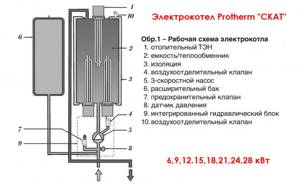
Depending on the design and manufacturer, the equipment may have different configurations.
- Electronic control unit. Regulates the temperature by turning the equipment on and off at the right time.
- Circulation pump (heat pump). It is a mandatory component of the system and maintains a stable speed of coolant movement in the circuit. It produces forced circulation of liquid and creates the necessary pressure in the system, while ensuring the most effective heat exchange and heating of the room.
- Expansion tank. Not all types of electric boilers with a pump are equipped with an expansion tank. Therefore, if you purchase equipment without a tank, you will need to purchase this part separately and install it by cutting it into the pipe heating circuit.
- Filters. They purify and remove various impurities from water.
- Safety valves. Protect the system from unwanted deviations in operation.
- Safety valve. Connected to the return pipe. Performs emergency water release when the pressure rises above the established norm.
- Pressure gauge. This device determines the pressure of liquids and gases inside the boiler and pipes of heating systems; it is necessary for monitoring.
- Thermal switch . Shuts down equipment when it overheats. Connected to a temperature sensor located at the top of the electric boiler.
- Automatic air valve. It is located above the heating tank and produces an emergency release of air from the tank in case of excess pressure.
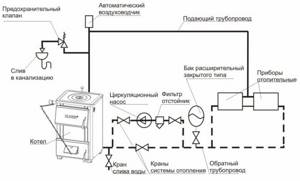
Types of electric boilers
Depending on the operating principle of the heater, all electric boilers are divided into three types.
Electric heating elements
The principle of operation is based on simple electrical heating of elements that give off their heat to the liquid. Heating element – heating element. Water or other approved liquids are used as a coolant, in accordance with the operating instructions.
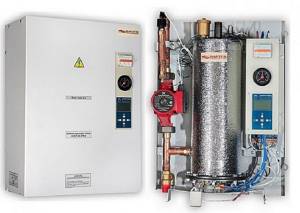
Induction
Their action is based on the principle of electromagnetic induction. The heating element is a coil, inside of which there is a pipeline filled with water. When an electric current passes through the coil under the influence of an electromagnetic field, the coolant heats up.
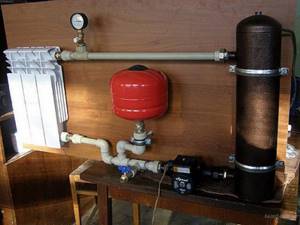
Ionic
The working element in such structures are electrodes placed in a special aqueous medium, where the process of heating the coolant occurs when alternating current passes through it.
A feature of the use of this type of boiler is the mandatory monitoring of the electrical conductivity of the liquid and the adoption of measures to regulate it. The phenomenon of electrolysis and breakdown should not be allowed. Failure to comply with these requirements may result in equipment failure.
The liquid used cannot be used for domestic purposes. The heat carrier, which circulates through the pipes and enters the working tank of the boiler, comes into direct contact with the electric current. It is not recommended to carry out repair and commissioning work without the involvement of an experienced technician.
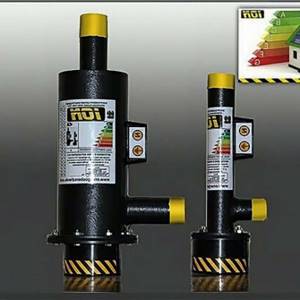
in the boiler will continue to fall, then when it decreases below ...
Page 17
- Image
- Text
17
temperature in the boiler will continue to fall, then when it drops below 3 °C the boiler will be blocked. Warning:
this function is not active,
if hot water heating is controlled using a thermostat.
Pump jam protection
Running the pump briefly (approximately 1 minute) at minimum speed after it has been idle for 23 hours reduces the likelihood of blocking or clogging in the event of an extended period of inactivity. Warning:
This boiler function
impossible to block.
Two speed pump
The boiler is equipped with a two-speed pump with automatic speed switching function. The factory setting of the pump provides for the pump to operate at maximum speed when heating boiler water, and its run-down is carried out at a minimum speed. To heat the boiler water, the pump always runs at maximum speed. Note:
Setting parameters
The operation of the pump can only be carried out by an employee of a specialized service organization.
Pump run-on (running time)
When heating hot water in an indirect heating boiler, the pump run-out is 1 minute. When heating the heating, the pump run-out is 10 minutes. If necessary, the pump operating time can be changed using the services of a specialized service organization. Warning:
This function is active
only when the boiler is connected to the electrical network and the main switch is on.
Three way valve protection (only
in case of connecting a boiler
indirect heating with NTC sensor)
If the indirect heating boiler was
connected to the boiler through a three-way valve, then protecting this valve from jamming, if no commands have been received to heat hot water in the boiler for the last 23 hours (the valve was constantly in the same position), is carried out by switching it to the opposite position.
Disconnecting the boiler from the electrical
networks
It is recommended to disconnect the boiler from the electrical network only in case of repairs, maintenance work or a long shutdown (see section “Switching off the boiler”). When the boiler is disconnected from the electrical network, all its protective functions are deactivated.
Power outages
In the event of a power outage, the boiler will turn off. When the power supply is restored, the boiler will automatically turn on without losing the previously set operating parameters. If the boiler does not start working after the power supply is restored, contact a specialized service organization.
Safety valve
The boiler is equipped with a safety valve with an opening pressure of 3 bar. DO NOT TOUCH THE VALVE! If the safety valve is triggered (boiler water is drained), it is necessary to turn off the boiler, disconnect it from the electrical network and contact a service organization. If the water pressure in the heating system decreases again, you must consult with specialists from your service organization. Warning:
All of the above
The boiler's electronic protective functions are only active when the boiler is connected to the electrical network and the main switch is on.
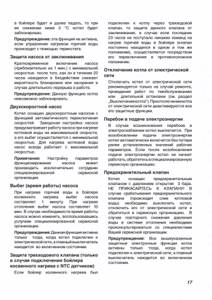
If the boiler does not turn off
The boiler does not turn off on its own due to the fact that the automation does not work. This can be caused by a breakdown of the temperature sensor or the device that is supposed to disconnect the contacts.

You can disassemble it, check and clean the contacts, and determine whether any of the wires in it have burned out. If all the wires are intact and the contacts are clean, check the operation of the automation. When it works well, but the boiler does not turn off, it means that the temperature sensor is broken. It will have to be replaced.
Maintenance and care
Page 18
- Image
- Text
18
Maintenance and care
Heating system recharge
The heating system can be fed (but only in small quantities) using a feed valve, which is recommended to be installed at the boiler water inlet into the boiler (the feed valve is not included in the boiler delivery package). When recharging the heating system, the following requirements must be observed:
— The pressure in the cold water system should be
necessarily higher than the water pressure in the heating system
— Water is fed into the boiler
exclusively in a cooled state (the temperature of the coolant in the boiler should not exceed 30°C),
— Recommended pressure value
The water in the boiler when cold (up to 30 °C) should be in the range of 1 to 2 bar.
— Check the settings of the expansion
tank and, if necessary, adjust it.
The manufacturer does not accept any liability for damage resulting from improper handling of the make-up valve and failure to comply with the above requirements.
The resulting
Malfunctions are not subject to the boiler warranty. The procedure for adding water to the boiler:
• make sure that the boiler is connected to
mains and the main switch is on
• make sure that what is shown on
On the boiler display, the current value of water pressure in the heating system is below 0.8 bar, and the “bar” LED is flashing on the boiler control panel
• open the make-up valve slightly and watch
for pressure increase on the boiler control panel or on the pressure gauge on the bottom side of the boiler
• fill the system with water so that it
the pressure reached 1 – 2 bar
• after setting the required pressure
manually close the make-up valve
• carefully remove air from all
heating radiators (water should flow out evenly and not contain air bubbles)
• make sure that what is shown on the display
the pressure is between 1 and 2 bar. If necessary, add water to the system.
Boiler maintenance from outside
user
The boiler casing can be cleaned with a damp cloth, then wiped dry with a dry cloth. Do not use abrasives or solvents to clean the boiler. Warning:
Before starting work
The boiler must be turned off via the main switch.
Regular technical
service
Once a year, preferably before the start of the heating season, it is recommended to service the boiler. Servicing is performed by employees of a specialized service organization. This service is not subject to warranty.

Prevention and recommendations for use
Compliance with operating rules, together with the implementation of timely preventive measures, extends the period of trouble-free operation of the unit. It is preferable to carry out preventive maintenance during the lowest load of the boiler, in the summer.
During the current heating season, it is advisable to pay attention to problems and deviations that arise during operation. In the warm season, it is recommended to replace all unstable elements and troubleshoot problems. Then carry out a preliminary launch and check the functionality of the boiler equipment and systems.
Warranty and warranty conditions Transportation and storage of T...
Page 19
- Image
- Text
19
Warranty and warranty conditions
Transportation and storage
It is recommended to transport and store the boiler in its original factory packaging - it is necessary to limit force on the packaging, avoid impacts and, except for the moment of unpacking, do not place the boiler in a position in which it could fall out of the packaging. The boiler must be stored under appropriate standard conditions (non-aggressive and dust-free environment, temperature difference from 5 to 50 °C, air humidity up to 75%, limitation of biological influence, shock and vibration).
The warranty for an electric boiler manufactured by PROTHERM SKAT is provided if the Product Data Sheet is available and other conditions specified in the Operation Manual and Installation Manual are met (sections “Introduction”, “Installation of the boiler”).
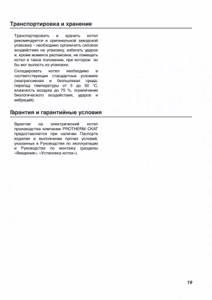
Noise in the middle of the tank
If the boiler is making noise, then you need to listen to the sounds.
- The noise is uniform and monotonous.
- The noise is uneven. Cods are heard.
If the boiler makes noise evenly and monotonously, then there are no problems with its operation. The source of noise is the heating of water. This noise can be weak, or it can be loud. It all depends on whether the heating system is open or closed. If it is open, the boiler makes louder noise. The reason is the presence of air in the coolant .
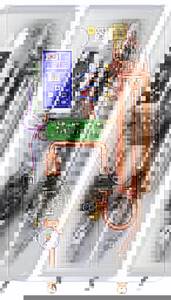
When the boiler makes uneven noise and crackles are heard, this is a breakdown. The cause may be scale on the heating element. The high temperature of the heating element causes the scale to heat up, which is accompanied by increased noise. Uneven sound and crackling occurs due to the fact that the thickness of the scale in individual areas of the heating element is different. The noise is generated like this:
- First, thin deposits of limestone are heated. They don't make too much noise.
- Thicker deposits are then heated. They take longer to heat up. That's why they hum louder than fine deposits.
- The cracking sounds are very thick. This sound can also be created by plaque, which has begun to lag behind the heating element.
Other faults
Error 00
Temperature sensor malfunction (shutdown).
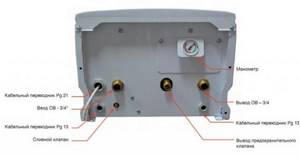
Connection terminals for the Proterm Skat boiler
What to do:
- You need to reconnect it.
- Look through its contacts and clean them if necessary.
- Check its functionality and replace if necessary.
Error a6
It occurs due to low air temperature in the room where the boiler is installed, simply put, in the boiler room. To eliminate it, increase the temperature by installing a radiator in the boiler room.
Error f04
Indicates problems with ionization. Restart the device and see if the gas valve is closed.
If the boiler does not heat the water
It does not heat the coolant due to failure of the heating element, provided that all other components and indicators are working. Repair of electric boilers is carried out as follows:
- Disconnect the device from the power supply, close the shut-off valves and drain the water from the boiler.
- Remove the housing of the electric heating boiler.
- If it is impossible to get to the heating element, other parts are dismantled.
- Unscrew the bolts that hold the heating element.
- They take out the heating element and put another one with the same characteristics in its place. At the same time, change the gasket.
- Fix the heating element with bolts.
- Install other components if they were removed.
Next, install the protective casing and check the functionality of the device.
Advantages and disadvantages of Proterm Skat boilers
Most of these disadvantages and advantages are inherent in most boilers operating on electricity.
Pros of Protherm Skat boilers
- High efficiency
- Easy to install
- Unpretentious in maintenance
- Eco-friendly
- Doesn't require much space
- Silent operation
Disadvantages of Skat series boilers
- High cost of electricity
- Dependence on power outages
Sometimes electric boilers are credited with shortcomings that are no longer relevant or were obviously incorrect; let’s look at some of them:
The boiler power is not enough to heat a house larger than 300 m2
This statement is incorrect, due to the fact that Skat boilers can be connected in a cascade to increase the heated area, if there is a shortage of 28 kW.
Frequent replacement of the heating element
Due to the fact that the heating medium is heated using a heating element, many believe that such a heating element will not last long, but you need to take into account the quality of the heating element itself and do not forget that it is not water that circulates in the system, but a coolant.
Basic error codes
Next, we will consider the main malfunctions of the Proterm gas boiler, error codes and possible options for correcting them.
f1
Error F1 (f1). Loss of flame, ignition is blocked and gas supply to the gas valve is stopped. This happens when the board does not receive a signal about the presence of a flame from the ionization electrode, while the gas valve is open, the protective mechanism is activated and the boiler turns off.
The cause may also be insufficient gas pressure. To eliminate this, press the reset button and check if the gas valve is open, and it would be a good idea to check the plug in the socket, turn it over, reversing the polarity.
Also, error F01 often indicates the thermostat is overheating; to fix it, try pressing the reset button on it. This problem occurs very often in the Proterm KLOM model.
f2
Error f2 (f2). The heating circuit temperature sensor has failed, or the coolant temperature has dropped below 3 degrees. The device is locked because ice may form. Often this indicates a sensor failure; check it and, if necessary, replace it with a new one.

Heating circuit temperature sensor
However, this situation can be caused by starting the device in the winter season, when the temperature in the system is really insufficient. To start the system, increase the temperature in the system.
f3
Error f3 (f3). This error signals that the boiler is overheating and means that the permissible critical maximum of 95 degrees has been reached, the protection is triggered and the boiler automatically turns off.
Wait until the temperature drops below this indicator, the boiler will start on its own. If this situation occurs again, reset the thermal fuse.
f4
Error f4. The DHW sensor has failed, when this breakdown occurs, the boiler operates as usual to heat the heating circuit, and heating of the liquid for domestic needs stops. Often, such a breakdown indicates either that the sensor has failed and needs to be replaced, or that the contacts have oxidized; clean and inspect them.
f5
Error f5. Damage to the external temperature sensor. In the event of such a malfunction, the device operates, but the temperature control is carried out by the boiler temperature sensor. To eliminate this, check whether there is a mechanical break in the boiler-sensor circuit; if there is no break, it needs to be replaced.
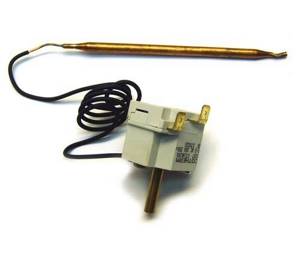
Boiler temperature sensor Proterm
f6
Error f6 (f6). Indicates a break in the exhaust gas sensor. Ring the connecting wires between the sensor and the board. The board may be faulty; take it to a service center for diagnostics, or the sensor itself may be faulty. This breakdown may be caused by a faulty ignition transformer, check it.
f7
Error f7. The instructions describe the error as a connection failure. This gap can be anywhere, and means that when connected to the controller, a signal does not arrive from one of the elements, or there is not enough voltage at the terminal on the control board.
You need to visually inspect all the wires, test them for breaks, check all connectors. It is also possible that the board itself has failed and needs repair. If you cannot find anything, seek qualified help from a specialist.
f8
Error f8 Indicates that the NTC sensor circuit is open and the DHW boiler is grounded. Ring this circuit of connections, disconnect and reconnect these elements, as the contacts may have come loose. If these manipulations do not produce results, replace the sensor.

f10
Error f10. Indicates a short circuit of the NTC temperature sensor on the supply line.
This fault appears on the display if:
- A short circuit has occurred in the NTC device installed at the OB input. In this situation, it needs to be completely replaced.
- It is also possible if the voltage level in the circuit has dropped to 0.40 V.
- A short circuit has occurred in the device plug. What to do in this situation? Only its complete replacement, cannot be repaired.
f15
Error f15. Short circuit of the reverse draft sensor. The combustion products controller is located at the top of the boiler, it is connected to the fan tubes.
It is necessary to disassemble, clean all terminals, and remove deposits from the tube. If this procedure does not bring results, you will need to replace it with a new device.
f20
Error f20 (f20). The safety temperature limiter has tripped. The supply line temperature sensor may be connected incorrectly, causing the temperature to rise above the permissible limit (95 degrees) or an open circuit to occur.

Gas boiler temperature limiter
Call it, if you do not find a malfunction, try reconnecting it. Check if the pump is working properly and bleed air. If you are unable to solve this problem yourself, seek help from a specialist.
f22
Error 22. This problem indicates low fluid pressure in the heating circuit of less than 0.3 bar.
Possible reasons for this:
- Faulty fluid pressure sensor. Needs to be replaced.
- The malfunction is either the pump is blocked or its operation is not adjusted. Clean it and check for proper operation.
Add fluid to the system. Check all elements for leaks, as pressure may drop due to a leak; if found, fix it.
f23
Error f23. Exceeding the permissible temperature difference between the supply and return lines.
This could happen as a result of the following:
- Pump malfunctions, check it, replace if necessary.
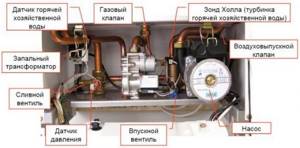
- There may be a malfunction in the sensors, check them, measure their resistance.
f24
Error f24. The liquid level in the heating circuit is low, the temperature is rising very rapidly.
This may have happened due to:
- Pump blockage or insufficient performance.
- The system has become airy and, as a result, the pressure has decreased; purge it.
- Highway closure. See if all the taps in the system are open.
f25
Error f25. The protection system against carbon monoxide penetration into the room has been activated. Why does the boiler turn off? When this malfunction occurs, the relay contacts open due to a disruption in the air flow.
The reason may be:
- Depressurization of chimney connections, violation of its joints.
- Also check the functionality of the thermostat using a multimeter for a short circuit or open circuit.
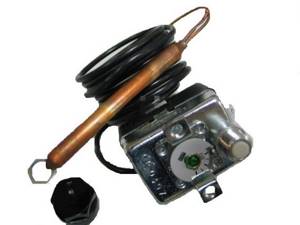
Boiler thermostat Proterm - Check if the fan is working properly.
- Check draft and supply ventilation.
- There may be a malfunction of the control board.
f28
Error f28 (f28). Flame goes out when turned on.
The following reasons for this malfunction are possible:
- Gas supply failure. Low pressure in the system, check if the gas valve is open. If there is air in the system, it is necessary to restart several times. Incorrect gas system setting.
- The ionization electrode is faulty, clean with fine-grained sandpaper, soot may accumulate.
- Check the grounding of the device. It is also possible to solve this problem by pulling out and inserting the socket on the other side (reversing the polarity).
- The electronic board has failed. Needs replacement.
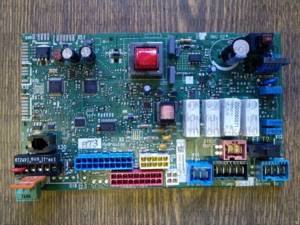
Proterm boiler board
It would also be useful to clean the entire ignition group, including the burners.
f29
Error f29 (f29). The flame goes out while the boiler is operating.
Let's look at the possible reasons:
- There is no gas supply to the boiler. There may be no gas in the main, you need to contact the gas service.
- Check the device grounding, phase, zero.
- The reason may also be a clogged burner; to do this, remove the casing from the boiler by unscrewing two bolts. Next, check the condition of the burner and clean it if necessary.
f33
Error f33 (f33). The anti-frost protection system in the fan is activated. The contact in the relay does not close.
Possible for several reasons:
- The pressure switch is faulty, check the resistance for short circuit and open circuit.

Gas boiler pressure switch - Check the integrity of the fan and the ventilation system as a whole. It is also possible for icicles and frost to build up in the chimney if this happened during the winter.
f55
Error f55. Carbon monoxide sensor malfunction.
You need to check the following:
- Status of contactors and relays. If you find sticking, then use fine-grained sandpaper to clean them and degrease them.
- The control board may be faulty and needs to be replaced.
f62
Error f62. Gas valve is faulty.
What should be done:
- Try restarting using the “restart” key.
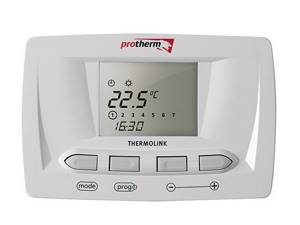
- Inspect gas fittings and connections for leaks.
- The electronics have failed. The board will need to be replaced.
- Overhaul, clean and lubricate the gas valve.
f63
Error f63. Memory board failure.
Repair:
- Try restoring the device's power settings using the plus and minus keys on the BAR, then press and hold the OK key until 0 appears on the display. After that, use the “plus” key to set 93, press “ok”.
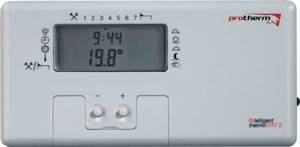
Make a selection according to the power of your boiler 1-6 kW, 2-9 kW, 3-12 kW, 4-14 kW, 5-18 kW, 6-21 kW, then click on “ok” and “plus” at the same time. Then, after a minute, turn off the boiler completely, wait 5 minutes and turn it on again.
- You can install a new board yourself, and if this does not give the required result, you need to contact a service center to solve this problem.
f72
Error f72. Difference in readings of flow and return line sensors. Every 24 hours or during startup the boiler performs a self-diagnosis (system test), this test was not successful. The boiler compares the readings of these sensors.
The reason may lie in the following:
- The control board is faulty and needs to be replaced.
- The pump is faulty or clogged. Check that it is working correctly.
- Incorrect operation of one or two sensors. Test and inspect them, check visually to see if there is a break or perhaps a contact has come loose.
- The heat exchanger is clogged. Well, here you will need to clean it, you can use purchased reagents or prepare your own solution from citric or acetic acid.

Boiler heat exchanger Proterm - The filter is clogged. Clean all water filters.
- The tap is closed.
f73
Error f73 Indicates a non-connection or short circuit in the pressure sensor.
Check the following:
- Is the sensor connected and is it connected correctly? Try removing it and installing it again in its original place.
- Test it with a multimeter for open or short circuit.
f75
Error f75 (f75) Repeated malfunction in the pressure sensor. After the pump has been started five times and the pressure has not exceeded the norm of 50 mbar.
Possible reasons:
- Check the functionality of the pressure sensor and whether the pump is working properly.
- Possible airing of the heating circuit pipes.

- Insufficient fluid pressure in the system.
f83
Error f83 Indicates that there is no coolant, the temperature does not increase when the burner is turned on. Airing of the circuit is possible.
What should be done:
- Fill the system with liquid.
- Check the expansion tank for leaks and repair or replace if necessary.
- Check the system for leaks. If a leak is found, repair it.
f84
Error f84. Indicates a stable temperature difference between sensors NTC2 and NTC5.
Correction:
- Check that these devices are connected correctly.
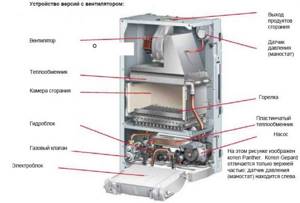
Proterm Panther boiler diagram - Check them to see if they are working properly. If they are defective, replace them.
f85
Error f85. The flow and return sensors are faulty.
In this case:
- Look, maybe the contacts have gone missing.
- Restart your device.
- When the temperature in the boiler circuit drops below 3 degrees, a blockage occurs. Raise the media temperature.
